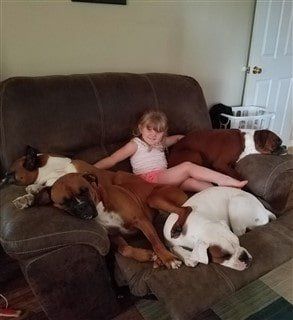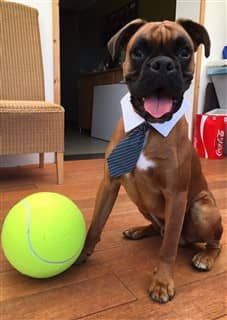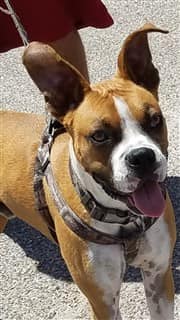How to Train a Boxer Dogto Stop Jumping Up
Overview
It's really common for Boxer puppies and dogs to jump on people; in fact, this exuberant behavior is one of the top issues that owners encounter with this breed. Even Boxer pups are pretty powerful, so jumping may be especially troubling if this is being done to children or seniors. And growing adolescent and adult Boxers can practically plow over just about anyone.
If your Boxer keeps jumping up to greet you, or your guests, you may be wondering if this is an inbred trait that's hard to train for, or if it is straight-forward to teach a Boxer to keep his paws on the floor.
You'll be happy to know that you can indeed train your Boxer to stop jumping, all the while still allowing your dog to express himself.
This section will cover puppies, adults, jumping on owners, and jumping up on visitors; all of which needs to be dealt with in slightly different ways.
Please note: AllBoxerInfo is reader-supported. Some of the product suggestions on this page are affiliate links. As an Amazon Associate we earn from qualifying purchases. This is at no extra cost to you and helps keep this site running.
Why Boxer Dogs Jump
Boxer dogs jump on people for one reason: to greet them. While some may just thump their tails on the ground, circle around a visitor, or give a quick lick, many Boxers are not naturally that reserved. This is a very outgoing, expressive breed. So, with many Boxers, a 'hello' is done in a huge way.
In other words, your Boxer won't be like a neighbor with a lazy wave as you pass paths in the morning, but rather will be like your best friend who's thrown back a few brewskis and has no qualms to express how psyched they are to see you.
The happier a Boxer is to see the target, the more enthusiastic the jump. So, it's common for a Boxer to jump up after being left home alone for a while, or when greeting someone whose company they really enjoy.
Though those who are not ready for it or are not a physical match for a Boxer may stumble back, this is not the Boxer's intention. The goal is to be on a more equal physical level with a person, and bring their face up to theirs. After all, hellos are not done to someone's arm or leg.
Some Boxer will lick, some will not. The main objective is to gain attention, receive attention back, and feel satisfied that it's abundantly clear that the Boxer is happy to see someone.
Prepping to Train Your Boxer to Not Jump

Boxers from left to right: Rocky, Hope, Angel, and Cocoa, Arabella Rose sits in the middle of this awesome Boxer dog pile, photo courtesy of Cynthia Provines
Take Your Place as Leader
For any sort of training to be successful, an owner must be seen as a leader. If not, you will hold no perceived authority to give commands or be listened to.
You may assume that your Boxer naturally knows that you are the leader. However, canines see the world differently than we do. Your Boxer has no idea what you went through to get him, doesn't understand that you own the house, and has no concept of money including how much of it you spend to take great care of him.
So, before you try to teach your Boxer to stop jumping up, you'll need to make it exceedingly clear that you are the leader (Alpha) and deserve a level of respect that includes being listened to.
How is this accomplished? By doing a few things that make sense in the canine world.
1.
Food. Food speaks to dogs as no other element can; they instinctively know that it equals survival. So, whomever supplies the food is highly regarded and just this alone can put that person clearly into the leader role.
Training Treats
Once your Boxer sees you as leader, he'll be much more prone to take your commands seriously; in fact, those with stubborn Boxers
often see great improvement once this is established. However, in addition to that, any sort of training, including that for jumping up, will work faster if the Boxer has motivation. The bigger the benefits to listening, the faster a dog learns to choose the right course of action.
So, training treats play a big role. The treats should not be something that is given out at any rate; they should be a special snack that is only handed out for good behavior. For training, moist usually works better than dry. And in addition, the treats should be relatively small; rewards need to offer immediate satisfaction and should not be something that a dog needs to sit down to chew on.
You'll want to have the rewards held to the same standards as your Boxer's kibble, which means made in the USA, and 100% all natural (no chemical preservatives, artificial additives, corn, soy, wheat, or by-products).
A good choice for Boxer puppies is Wellness Puppy Bites Grain-Free Training Treats ; these are perfectly sized, high-quality, soft training treats that come in either lamb and salmon or chicken and carrots.
; these are perfectly sized, high-quality, soft training treats that come in either lamb and salmon or chicken and carrots.
A good choice for adult Boxers is Wellness Wellbites Soft & Chewy Treats ; these are moist, ideally sized treats that are 100% all-natural. There's quite a few awesome flavors to choose from including chicken & lamb, chicken & venison, lamb & salmon, and turkey & duck.
; these are moist, ideally sized treats that are 100% all-natural. There's quite a few awesome flavors to choose from including chicken & lamb, chicken & venison, lamb & salmon, and turkey & duck.
Note:
Rewards must be given within 1 or 2 seconds of a desired behavior, so you can't go searching for them. Have several of them in a plastic sandwich bag and in your pocket for quick, easy access.

K.O, photo courtesy of Danielle
The Goal for All Scenarios
We'll cover several different types of situations in which a Boxer puppy or dog is jumping up, both in regard to age, and who the target is (you or guests).
For all of these, however, the goal will be the same. Boxers that do this are seeking attention. So, you'll be teaching your Boxer that jumping up does not bring about desired results, but that keeping all 4 paws on the ground does.
How Long Training Takes
If your Boxer only has an issue of jumping up on you, training can work as fast as a week.
If your Boxer keeps jumping up on other people, such as visitors to your home, training takes a bit longer. Part of the reason for this is because you'll need to recruit a helper that is someone outside of the household. Since training may not be able to take place every day, it can take several weeks.
How to Train a Boxer to Stop Jumping Up
Scenario 1: Training a Boxer Puppy to Stop Jumping on You
If your Boxer puppy has a habit of jumping up on you, consider yourself lucky; it's much easier to train a Boxer for jumping when the dog is small, and these lessons will be learned before your pup grows into a much larger adult.
Be sure that everyone in the household is on the same page and reacting in the same way so that the lesson is quickly learned.
1. When your Boxer pup first leaps up toward you, gently yet firmly hold his front paws, preventing him from touching your body.
2. Do not release the paws until your Boxer shows signs that he wishes to be released. When the pup starts to withdraw, let the paws go, and allow him to place them on the ground.
3. As soon as the paws hit the floor, offer enthusiastic praise, rub his head, and give lots of attention. But, do not offer a treat yet.
4. If he tries to jump up on you again, repeat the steps of holding his paws, and only releasing once he wants to drop down.
5. Once it is clear that the pup is not going to attempt to jump up again, give praise (Good boy/girl!) and offer one of your chosen training treats.
Scenario 2: Training an Adult Boxer Dog to Stop Jumping Up on You

This training can be done when a Boxer is jumping up on you, or any other adult members of the household.
It can also technically work on regular visitors to the house who are willing to do this; though, we do suggest looking to scenario #3 (ahead) for that, since you'll want to instill certain aspects that include having your Boxer on leash and listening to your commands, and treats are given in a different way.
The reason that the following training works, is because your Boxer is jumping up to greet you and wants his face to be close to yours. He also wants your attention.
With this, he will get neither until his paws are down.
1. As soon as you see your Boxer making a move to jump up on you, draw your arms up, crossing them over your chest, and turn your body so that at the most, your Boxer jumps to the back of your shoulder, and ideally your back.
2. Do not speak at all, since your dog's attempt to gain your attention includes hearing your voice.
3. Briskly, take few steps away, with your body still turned away from your Boxer.
4. Your move may have caused your Boxer to drop down. If he shuffled along with you, he will soon tire and drop.
5. When the paws touch the ground, turn and offer a super-happy greeting, along with pats.
6. If your Boxer jumps up again, immediately react in the same way, of crossing your arms, turning, taking a few steps, and not speaking.
7. As soon as he drops again, repeat the act of lavishing attention on him.
8. When your Boxer has soaked in the attention, and you feel that he will not attempt another jump, immediately offer praise and a chosen training treat.
Scenario 3: Training a Boxer Dog to Stop Jumping on Guests
Of all the types of jumping behavior, this one is the most involved since training requires that you locate at least one willing helper, and it's common to not have an opportunity to train each day.
The more often you train your Boxer, the faster he'll catch on. So, now's the time to call in a few favors, and see if you can get assistance from friends at least 3 to 4 times a week. Note that you can have just one certain person help you, but ideally you will want several different people to take turns doing this, so that your Boxer learns to greet without jumping with a variety of people.
Ideally, these will be people that your Boxer has a history of jumping up on. If you really can't find anyone (where do they all go when you need them?), you can
substitute a member of the household.

The goal
is to have your helper ring the bell and enter the house, while you are at the ready with your Boxer to help him reel in his excitement. Together, you and your helper will teach your Boxer that the attention he craves will only be given when his paws stay on the ground. Treats will be used as a distraction to keep your Boxer down, and to reward good behavior.
1. Have your Boxer on leash and harness. A harness allows you much better control, and is the safest way to restrain a dog from leaping. Hopefully, you already have a great harness for your Boxer, for his daily walks and other types of training. If not, you may want to consider one like the Front Range No-Pull Adjustable Dog Harness .
.
2. Standing inside the house approximately 10 feet from the entryway, and while firmly holding the leash, command a 'Sit'.
3. Once your Boxer is sitting, give praise (Good, sit, good dog), but do not give a treat.
4. Have the leash on the floor, and use your foot to hold it in place. Be sure it has some slack, so that your Boxer can attempt to jump. After all, if he's not allowed to try, he can't learn to control it.
If you find that you cannot keep the leash in place with your foot due to your Boxer's strength, you may switch to holding it in your hand, but do give it a bit of slack.
5. Your guest will now enter.
6. As your Boxer comes out of his 'sit' and moves forward, have your guest turn his back, and retreat several steps. Note that crossing the arms is not needed for this training, since your Boxer will not be close enough to touch your helper.
Your helper must remain with his back turned to your Boxer and should not be speaking at all (talking to you can be misinterpreted as speaking to your dog).
7. Repeat the 'Sit' command. Once your Boxer sits this time, sprinkle 2 to 3 treats on the floor. This will help to keep him in place as he's tempted by your helper.
8. Have your helper once again approach.

Did you find this article to be helpful?
Check out these other great articles:
Helping a Boxer Live a Long Life
- Take our quiz to see how you score on care elements, then read how each aspect can contribute to a long and healthy life for your best friend.
When a Boxer is Home Alone
- It's very common for Boxers to have trouble with separation anxiety. Fortunately, there are several things you can do to help.
